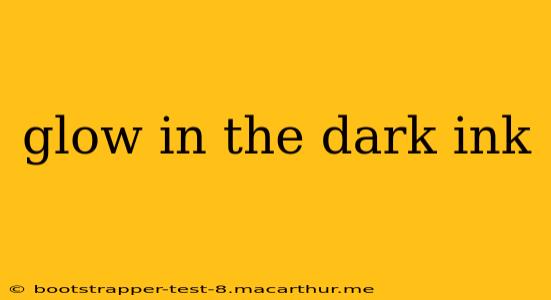Glow-in-the-dark ink has captivated imaginations for decades, transforming everyday objects into luminous wonders. From artistic projects to practical applications, this unique ink offers a captivating blend of creativity and functionality. This comprehensive guide explores everything you need to know about glow-in-the-dark ink, delving into its properties, applications, and the science behind its mesmerizing luminescence.
What is Glow-in-the-Dark Ink Made Of?
Glow-in-the-dark ink, also known as phosphorescent ink, doesn't generate its own light like a lightbulb. Instead, it relies on a process called phosphorescence. This involves incorporating phosphors, typically inorganic materials like zinc sulfide or strontium aluminate, into the ink base. These phosphors absorb energy from an external light source, such as sunlight or ultraviolet (UV) light. Once the light source is removed, the phosphors slowly release this stored energy as visible light, creating the characteristic glow. The type of phosphor used significantly impacts the color and duration of the glow. Strontium aluminate, for example, generally provides a longer glow time than zinc sulfide. The ink base itself is usually a polymer binder that suspends the phosphors and facilitates application.
How Long Does Glow-in-the-Dark Ink Glow?
The duration of glow depends heavily on several factors:
- Type of Phosphor: As mentioned, strontium aluminate-based inks generally glow longer than zinc sulfide-based inks.
- Amount of Phosphor: A higher concentration of phosphors usually results in a brighter but shorter glow. Conversely, a lower concentration might offer a fainter but longer-lasting glow.
- Charging Time: The longer the ink is exposed to a strong light source, the brighter and longer it will glow.
- Environmental Factors: Temperature and humidity can also affect the glow duration.
Generally, you can expect glow-in-the-dark inks to glow for anywhere from a few minutes to several hours after being charged. High-quality inks boasting strontium aluminate can even glow faintly for many hours, and sometimes even several days.
Is Glow-in-the-Dark Ink Toxic?
The toxicity of glow-in-the-dark ink varies depending on the specific formulation. Many commercially available glow-in-the-dark inks are non-toxic and safe for use in various applications, including arts and crafts. However, some formulations might contain chemicals that could be harmful if ingested or if prolonged skin contact occurs. Always check the manufacturer's safety data sheet (SDS) for specific information on the composition and safety precautions. For children's projects, opt for inks explicitly labeled as non-toxic and supervise their use.
What are the Different Types of Glow-in-the-Dark Ink?
Glow-in-the-dark inks come in various forms, each suited for different applications:
- Acrylic Inks: These are versatile and commonly used for painting on various surfaces like canvas, wood, or fabric.
- Water-Based Inks: Ideal for pen and ink applications, but might not be as vibrant or long-lasting as acrylic inks.
- Fabric Inks: Specifically designed for use on fabrics, ensuring the ink bonds well with the material and withstands washing.
- Specialty Inks: Certain inks are formulated for specific applications, such as screen printing or airbrushing.
How to Make Glow-in-the-Dark Ink at Home?
While making your own glow-in-the-dark ink can be a fun project, it requires careful handling of potentially hazardous materials. It's crucial to follow safety protocols and wear appropriate protective gear. The process typically involves mixing phosphor powder with a suitable binder, such as acrylic medium or clear nail polish. However, achieving a consistent and vibrant glow requires precise measurements and thorough mixing. Due to the complexity and potential safety concerns, we recommend purchasing commercially available glow-in-the-dark ink for most projects.
What are the Best Uses for Glow-in-the-Dark Ink?
The creative applications of glow-in-the-dark ink are practically limitless. Here are just a few ideas:
- Artistic Projects: Painting on canvases, creating glow-in-the-dark murals, or designing unique clothing items.
- Crafts: Decorating ceramics, enhancing model kits, or customizing everyday objects.
- Practical Applications: Marking safety hazards in dark environments, creating unique lighting effects, or designing custom signage.
Glow-in-the-dark ink opens up a world of exciting possibilities for both artistic expression and functional improvements. Its captivating luminescence continues to inspire innovation and creativity.
